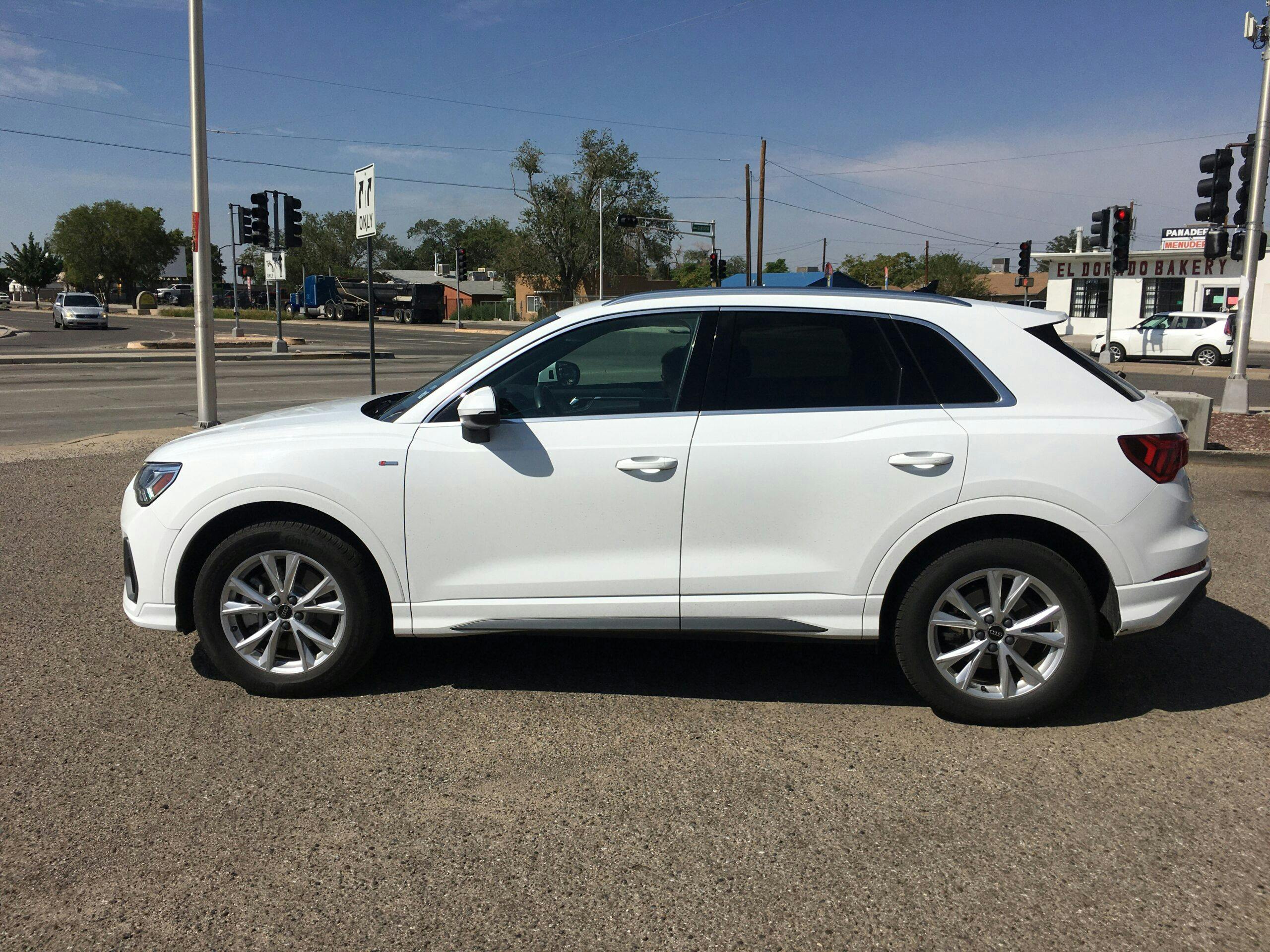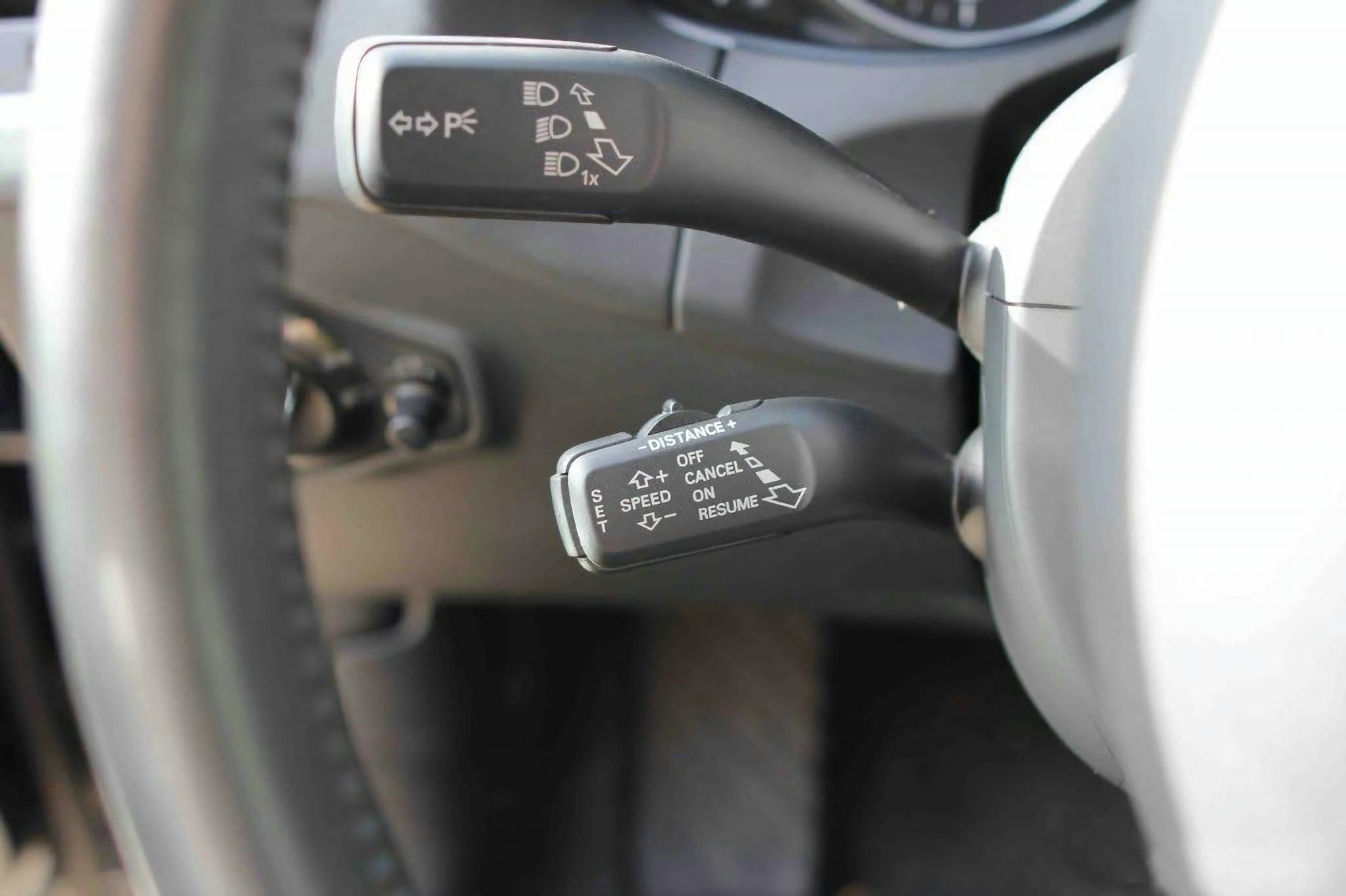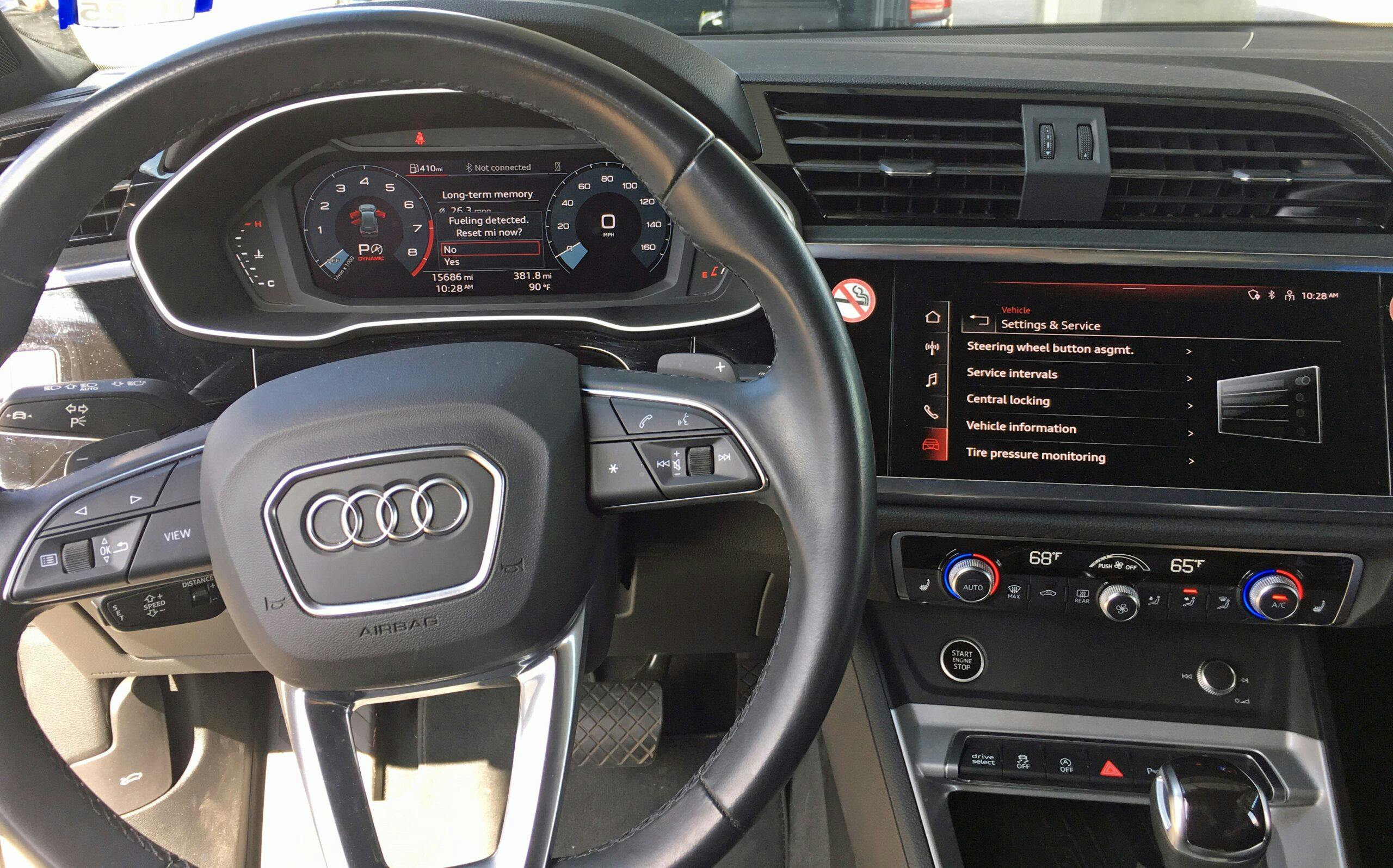The Surprising Rental Car
My wife and I just returned from visiting our middle son in Santa Fe. For rental cars on these and other trips, I like using National. In addition to still getting a good rate through the account number of my old engineering job, I like the “choose any car in the aisle and go” thing. When we were last in Santa Fe two years ago, I selected a brand-new Toyota Corolla, figuring that I didn’t need the ground clearance or traction of an SUV, and because I wanted to glimpse the safety features that come standard on a bread-and-butter Japanese sedan. After all, Maire Anne and I are entering our Geritol Years, I don’t have the visual acuity to drive any distance at any hour like I used to, and a few dings and chimes (or a sharp jab in the ribs) to prevent me from doing something stupid might not be a bad thing.
As I wrote here, I absolutely hated the Corolla. The combination of the lane-assist feeling like it was yanking the steering wheel out of my hands and the auto-dimming headlights that kept shutting down the high beams on nearly empty roads in favor of using low beams whose illumination profiles were downright unsafe was enough to make me scream.
To be clear, although I love vintage cars and did the “old man yells at clouds” thing at the Corolla, I’m not an automotive Luddite who thinks that everything built after the DOT instituted 5-mph bumper standards in 1974 and the EPA put the wrench to smog in 1975 is garbage. There’s no question that newer cars are better than older ones in the objective measures of safety, power, economy, and emissions, and that if you want to arrive somewhere not looking like you’ve been put in a Waring blender or smelling like such a high concentration of unburned hydrocarbons that you might spontaneously ignite, you take the newer car, not the 50-year-old one.
But my daily-driver 2003 BMW 5 Series is now over 20 years old. My wife drives a 2013 Honda Fit, so that’s a bit newer. But neither of them even has Bluetooth, much less active safety offerings. Renting a car while traveling is my main vector for experiencing the influx of these sorts of features. Since my last reaction to said features was negative, I was curious to try it again and see if it was just the implementation on that particular make and model.
Unfortunately, this time, the pickings in National’s “Emerald Aisle” at Albuquerque International Sunport were pretty slim, consisting of a giant pickup truck, two small Korean crossover SUVs, and a Chevy Malibu. As I walked past the pickup, though, I saw an Audi A4 sedan crouching next to it, and thought “score,” but someone was already in it. I asked the fellow in the booth if any more Audis were due in. He said that one should show up in about ten minutes. Sure enough, Audi #2 soon appeared. It wasn’t a sedan, though—it was a little Q3 Quattro crossover SUV. But hey, close enough. My wife and I threw our bags in the back and headed for I-25 north to Santa Fe.
My immediate impression was that something appeared to be wrong with the car, because you had to put your foot several inches into the accelerator pedal before anything happened. Later that day, I looked it up online, and found that many people complained about this lag, attributed to the turbo on the little 2-liter four-cylinder engine, the accelerate-by-wire system, the S-trontic transmission, driving in comfort mode instead of sport, or some combination of all four. But once I got accustomed to stomping on it to get it moving, I rapidly warmed to the car. Small crossover SUVs aren’t really my thing—they all look alike, and if you’re not going to have the size and towing capability of a truck, I’d rather have a wagon—but this one was what you’d expect of a German SUV, with a priority on handling and road feel. And the engine moved the car just fine once the revs were up.

Technology-wise, yes the Q3 did the same thing with the automatic lane assist that the execrable Corolla did, giving you the unnatural feeling that there was another hand on the wheel if you didn’t adhere to its overly fussy lane discipline, though perhaps with a bit more subtlety. I quickly figured out how to shut it off. And I couldn’t correlate most of its frequent beeping with anything obvious. Was I approaching an intersection? Train tracks? The restaurant that serves the best huevos rancheros? A mouse-laden vehicle with hantavirus? I never could be certain.
But the thing that really surprised me, the thing that I’d never experienced, the thing that I now want in my next car, wasn’t lane assist, or blind-spot detection, or auto-braking, or any of the safety nannies I thought I’d reluctantly allow into the room of my automotive dotage.
It was adaptive cruise control.
Those of you with vehicles that have the cruise control that’s been standard in many cars since the late 1980s probably play the same game with it that I do. You set it, then use the controls instead of the pedals, clicking the speed down when traffic slows your pace, and clicking it back up when it clears. You lose the game when you have to hit the brake or the accelerator pedal. Hey, it helps me stay alert on long drives, and it’s more consistent than trying to maintain speed manually. But there’s no getting around the fact that, if you have a major-league senior moment and space out, you’ll run right into the back end of the car in front of you.
Adaptive cruise control eliminates that risk by incorporating a sonar sensor in the nose of the car and slowing it down as you’re approaching traffic. The system in the Audi worked so well that I initially didn’t even realize it was doing it. It simply continued to drive with the cruise control on, but at a slower speed. When there was an opening in the left lane, I pulled in and the car sped back up to the previously-set threshold. A number of parameters are adjustable, but I didn’t change any of them. It worked so seamlessly that I instantly filed it away in my mind as a requirement for whatever “real car” we buy next. And yes, I’m probably the last person to find out about it. Sort of like learning that How I Met Your Mother, despite its stupid name, is actually really funny, at least when Neil Patrick Harris is in the scene.

Another thing I liked about the Q3 is that it’s the first vehicle I’ve driven whose central display didn’t look like someone took the screen off a laptop running Microsoft Windows XP (“Oooooh! 3D icons!”) and screwed it to the dash. The way that the look and feel of most dashboard screens have absolutely no relationship to the look and feel of the rest of the dashboard drives me crazy. On the Q3, the fact that the instrument cluster is electronic (no mechanical speedo and tach gauges) allows it and the central display to have the same look and feel. I’m sure this isn’t the first car to do this, but it’s the first one I’ve driven.

So. I can still do without the mystery beeping. And Bluetooth still drives me nuts (quit dropping the volume of the music to tell me to keep right!). And the odds of my running out and buying a Q3 are zero. But if there was a hundred-dollar adaptive cruise control retrofit for my BMW E39 and my wife’s Honda Fit, I would be all over it.
But keep your damn servo-controlled hands off my steering wheel.
***
Rob’s latest book, The Best Of The Hack Mechanic™: 35 years of hacks, kluges, and assorted automotive mayhem, is available on Amazon here. His other seven books are available here on Amazon, or you can order personally inscribed copies from Rob’s website, www.robsiegel.com.



In 17 years of playing “don’t touch the pedal” while commuting in nj I won it exactly once.
I’ve not driven any car with adaptive cruise control where I actually liked the feature. Quite the opposite. Yes, it slows you down when you come up on traffic and speeds up when you’re clear. But in my opinion, it is too sensitive and unpredictable, at least in the cars I’ve driven. More often than not, i’ve passed someone on the left and pulled back into the right only to have the vehicle slow down so much that the guy I just passed had to hit his brakes, all because there was a vehicle 1/4 mile ahead of me that was going slower. And I was not able to figure out how to change the settings even with the O&M manual.
I’m not a fan of adaptive cruise control. I will use regular cruise 99% of the time. I set the cruise at the speed I want and change lanes when needed to pass the slower car in the right lane. I would rather do that and maintain my speed constantly than slowing down at some invisible wall between me and that vehicle.
ACC is great when it works. I have a 2014 Audi A6 TDI (awesome MPG!) but the ACC or even just CC does not work because the camera no longer works. Estimated repair cost from Audi was $2400 which included a $1600 replacement camera… which is no longer made. I appreciate the simpler things in life and driving.
I recently drove a friend’s Jeep Compass (2021?). I experienced the lack of throttle response also. Apparently there is some software “throttle dampening” built in. I hate it! Give me a throttle cable! We are slowly losing control. Why teach someone to do something when you can program the car to do it for you? Some safety features are great, but we’re taking skill (and responsibility!) out of the driving equation. It’s just… wrong!!
my opinion might not be feasible since i haven’t driven a car with acc since the mid-aughts. that said, i didn’t care for it compared to standard cruise control. it had 3 distance settings. i thought the longest setting gave proper distance to the vehicle ahead of me. but there were too many people that would change lanes in front of me. after my car readjusted to the set distance, another car would get in front of me. and then there are the cars following me. seems they always selected the shortest distance setting. i labeled that as ‘tailgate mode’. i want to be in control of whatever I’m driving, rationally speaking. but consider my opinions with the thought that standard cruise control is possibly my favorite vehicle accessory.
Rob, I think you’d feel differently if using adaptive cruise in Boston traffic. It’s great at keeping a safe distance behind the car in front-the problem is other drivers will move into that space. Your cruise control will then drop back a safe distance, the pattern repeats itself, and you end up falling further and further behind
Toyota Corolla: Boring, awful interior, worse exterior, no road feel with steering wheel on centre, really a joke of an automobile, but they hang together fairly reliably. If this is what one wants, fine.
Audi A3: Technically OK. Parts and labour not inexpensive. Just not thrilling. The seats are very durable, but not comfortable.
BMWs, (any of them): As a fit and lean 6′-2″ man, unless it’s at least 25-years old, I just don’t seem to fit them properly and that ruins the experience a lot. Better seats than the Audi. More fun. Handle well. Stratospheric parts cost.
Volvos: Aside from the XC90, (which rides more like a 1968 Buick Electra), I love these things. I fit. They handle well. Parts cost is OK, labour a bit more expensive. No turbo lag worth talking about. Durable.
Adaptive Cruise Control: Great on my Volvo XC 40 for long trips on freeways or open roads without lots of traffic, (as there are far too many drivers who drive 15% below the speed limit and they seem to be reproducing faster than the usual rate for the remainder of the population). Wish I could retrofit this to my 1987 Class B motorhome, but not to my (would almost qualify as a retro-mod) 1977 Ford Capri Mark II that I’ve owned since new.
Bluetooth?
I’m a retired truck driver with about 4 million miles just in big trucks. We had cruise on the trucks I drove late in my career but I used it very seldom. I had so many miles driving with my foot as the cruise control I was very adept at maintaining a steady speed. I’ve found that with my 2021 Kia I get better mileage using my foot vs cruise because I can keep the speed/rpm at a better rate than the cruise can as the trans isn’t bumping the rpm up with every little rise in the road. Oh, & this is my 1st post of the day but the post police said I’m posting too fast! BS.
I have given up on car rental agencies at airports since I never get what I specify. I joined Turo, which is like Airbnb, whereby you rent cars from local residents and they meet you at the airport. The variety can make you giddy. At my little rural hometown I can get anything from a Prius to a Bentley Bentayga at rates far less than a car rental agency!
The “problem” with adaptive cruise control is its propensity to aggressively brake should someone pass you and then merge into your lane closer than the set perimeters are comfortable with. Once you accustom yourself to that, it can be a handy feature.
I must be the only person who HATES adaptive cruise control with a burning passion. You get within 30 or 40 yards of the car in front of you and your speed instantly drops 6-8mph until the buffer zone is re-established. First time it happened; I thought the transmission was roached. Then another car jumps into the buffer zone and the process repeats. Happens often enough in heavy traffic that it seems you’re going backwards. No thanks.
ACC in our 23 Prius prime is a non starter, approaching a turn on the freeway it brakes, I don’t know if there are settings but so far I just use “non adaptive” mode.